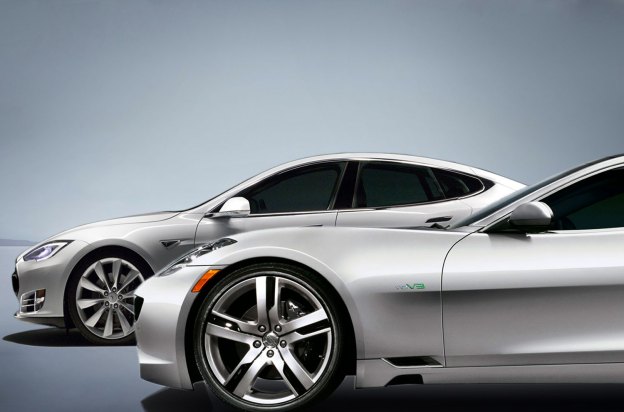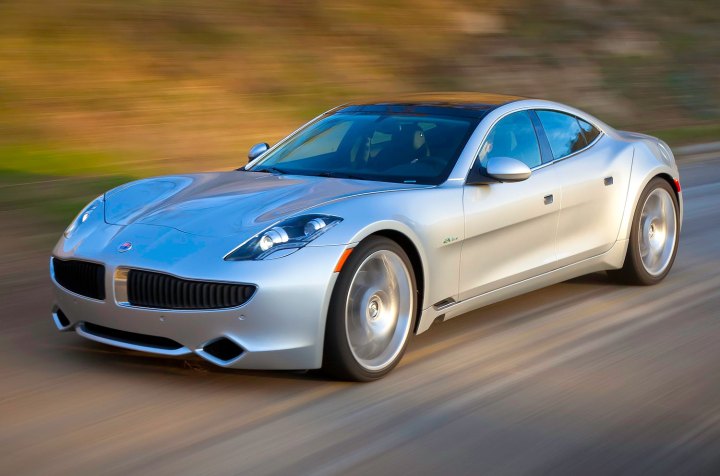
With their green powertrains and luxury aspirations, the Fisker Karma plug-in hybrid and Tesla Model S EV are natural rivals.
But will either brand survive?
With the sudden departure Wednesday by Fisker Automotive founder and figurehead Henrik Fisker from his struggling and stalled car company, not to mention Tesla’s own recent high-profile PR flaps (which we’ll get to in a minute), it’s time to take stock of the history of both car companies and more importantly, look at what may lie ahead for two of the standout start-ups in the high-end EV car market.
The visions
Like most upstart car companies, Fisker and Tesla are the brainchildren of dedicated individuals. These two men have added their names to a long list that includes John Z. DeLorean, Preston Tucker, and Malcolm Bricklin.
…Both cars look gorgeous, but the Karma deserves the nod for its originality in both exterior and interior design.
After making a fortune off online banking giant PayPal (now part of eBay), Elon Musk turned his attention to electric cars, founding Tesla Motors in 2003. He’s also the founder of SpaceX, whose Dragon capsule was the first private spacecraft to dock at the International Space Station.
From these disparate origins came two cars, the Fisker Karma and Tesla Model S, that are remarkably similar in purpose. Both were designed to be stylish, fast, and practical luxury cars that just happen to be better for the environment. However, they don’t just have to compete with each other; they also have to take on an industry that does not welcome newcomers.
The cars
Fisker and Tesla are car companies after all, not ego exercises. So how do the Karma and Model S stack up?
The Karma is powered by a 2.0-liter gasoline inline-four, with turbocharging and direct injection, two electric motors, and a 20.1-kWh lithium-ion battery pack. The Model S’ just has an electric motor and a battery pack, but the size of that pack depends on which model the buyer chooses. Tesla sells the car with 40, 60, and 85-kWh packs, which determine the car’s price and performance.
Fisker says the Karma will reach 60 mph in 6.3 seconds and hit a top speed of 125 mph. Tesla quotes a 4.4 second 0 to 60 mph time and 130 mph top speed for the top 85-kWh Model S Performance; a base 40-kWh car takes 6.5 seconds and tops out at 110 mph.
The EPA rates the Karma at 54 MPGE combined and, not surprisingly, it’s beaten by the all-electric Model S’ 89 MPGe. The Model S also beats the Karma on range, if buyers are willing to pay: the 85-kWh Model S has an EPA-rated 265-mile range, surpassing the Karma’s electric (33-mile) and total (240-mile) ranges.
The cheaper 40 and 60-kWh Model S variants have shorter 160 and 230-mile ranges, respectively. That base Model S starts at $59,900, but the max-range, max-speed 85-kWh Performance model starts at $94,900. All Teslas are eligible for a $7,500 federa tax credit.

The one flavor of Karma starts at $96,850, but loaded models cost $109,850. It’s also eligible for the $7,500 federal tax credit.
On the subjective side, both cars look gorgeous, but the Karma deserves the nod for its originality in both exterior and interior design. However, the Model S’ 17-inch touchscreen makes techies drool, and a completely flat floor and front trunk make the Tesla more practical.
The problems
Fisker and Tesla have each built a compelling (if expensive) product, and if that was all that mattered, the two companies would be on equal footing. Designing a dream car is one thing, building and marketing it is another.
Fisker brought the Karma to market first, but any advantage it could have gleaned from that was quickly eliminated by quality-control issues. In December 2011, Fisker recalled 239 cars to fix a potential coolant leak problem, only to have battery supplier A123 Systems fix the batteries again after Consumer Reports’ test car refused to start.

Things got worse from there. In May 2012, a Karma burned to the ground in Sugarland, Texas, taking a garage with it. Another, smaller fire in California forced a recall of 1,900 Karmas.
Fisker isn’t making any cars right now, because A123 Systems is bankrupt. The carmaker was negotiating its contract with A123’s new owners. Then comes news on Wednesday that founder Henrik Fisker has stepped down from the company. The future of the enterprise has never looked bleaker.
Tesla has had its share of issues, too. CEO Elon Musk started a very public argument with the New York Times after one of the paper’s reporters attempted to drive from Washington, D.C. to Boston using Tesla’s Supercharger fast-charging stations, only to end up on the back of a tow truck. While there are many opinions on who was right, the feud made Musk look silly and cast some doubt over the Model S’ ability to tackle long distance cruises.

Also, while no Teslas have caught fire yet, there have been a few quality issues. Jalopnik perused the Tesla Motors Club forums, and found hundreds of posts about unresponsive touch screens, spontaneously opening doors, and other maladies. Tesla says most of these issues can be fixed remotely with software updates.
To be clear, both companies have delivered roughly the same amount of cars to customers, although the Karma has been on sale longer. Just under 2,000 Karmas have been delivered since mid 2011, while Tesla delivered 2,650 units in 2012, most arriving in customer hands between August and December.
The timing
Tesla’s quality problems are minor compared to Fisker’s, though. The unreliability of A123 Systems has hurt the latter company, while Tesla builds nearly every component of the Model S itself. But Tesla’s experience might be its true advantage.
The Model S is Tesla’s second car. For it’s first car, the Roadster, Tesla did as much outsourcing as Fisker. The Roadster was based on another car, the Lotus Elise; all Tesla did was convert it to run on electricity.

The Roadster didn’t have a stellar quality record either. It was subject to a phenomenon called “bricking,” where letting the battery fully drain effectively seized the electric motor to the axle, making the car nearly impossible to move. Tesla chalked the problem up to operator error, saying it was the EV equivalent of driving a gasoline car without changing the oil. However, it didn’t clearly warn owners about the problem beforehand.
…The most encouraging part of the story might be that both companies have firm plans for the future.
Fisker Senior Director, Global Corporate Communications and PR Roger Ormisher said roughly the same thing about the Karma, describing it as an “icon product” that was never meant to be a big seller.
It’s also difficult to fault Fisker for the suppliers it chose. Valmet Automotive, which assembles the Karma in Finland, built the Porsche Boxster and Cayman until recently and has the contract to assemble the new Mercedes-Benz A-Class.
Prior to its implosion, A123 Systems was a well-regarded battery manufacturer with contracts to build electric car batteries for BMW and General Motors.
The future
Fisker and Tesla are two companies with impressive products and somewhat shoddy track records, which makes them sound a bit like DeLorean, Tucker, and Bricklin. With that in mind, the most encouraging part of the story might be that both companies have firm plans for the future.
The Fisker Atlantic will be cheaper and will compete more directly with the Model S and established luxury cars like the BMW 5 Series. It will feature the same “electric vehicle-extended range (EV-ER)” plug-in powertrain as the Karma, but with a BMW 2.0-liter inline-four as the range extender. It should be closer to the 5 Series in price as well.
The Atlantic is still 18 to 24 months out, and in the meantime Fisker is seeking a strategic alliance with a larger company that could provide it with cash or other resources needed to complete the car.

Fisker had secured a $529 million U.S. Department of Energy loan guarantee contingent on building the Atlantic at an ex-GM plant in Delaware, but the DOE stopped issuing checks after Fisker failed to meet certain milestones.
Tesla plans to launch the Model X, and SUV with vertically-hinged “Falcon doors.” They’re supposed to give the Model X, which is based on the Model S’ chassis, the utility of a minivan without uncool sliding doors.
However, Tesla recently pushed the Model X’s debut back to 2014. It has nothing to do with a lack of funds: Tesla says it will repay its $465 million DOE loan five years ahead of schedule. The company says its wants to further promote the Model S before launching its SUV.
The end?
Fisker began 2013 with deeper financial and PR scars than Tesla, but that doesn’t mean Elon Musk should be doing a victory lap.
Despite Fisker’s missteps (and Henrik bailing out), it would be unwise to discount the appeal of the Karma’s plug-in hybrid tech. Just look at the Chevrolet Volt, which clobbered the all-electric Nissan Leaf in sales last year.
Then there’s the real competition: BMW, Mercedes-Benz, Audi, and other established luxury brands. EVs and hybrids have their share of early adopters, but convincing mainstream customers to gamble on an untested brand peddling (relatively) untested tech will be tough.
The story of Fisker and Tesla, then, isn’t just about who has the better car. It’s that building a car company isn’t easy, something John DeLorean, Preston Tucker, and Malcolm Bricklin knew all too well.
- Related article: Is there an EV answer in Britain?
We want to hear from you: Would you buy a car from either of these companies? Why or why not? What’s your opinion on their future and the future of electric/hybrid vehicles as a whole? Leave a comment below.
Editors' Recommendations
- Tesla Model S vs. Model X: Which is right for you?
- Tesla launches more affordable Model S and Model X, but there’s a catch
- Tesla gives the Model S over 1,000 hp and a spaceship-like steering wheel
- How to buy a Tesla online
- Tesla Model S vs. Lucid Air










